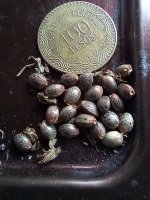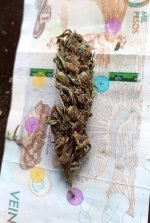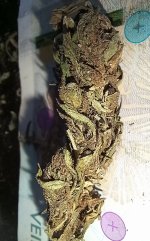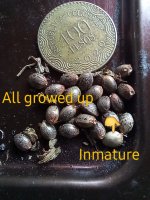-
Happy Birthday ICMag! Been 20 years since Gypsy Nirvana created the forum! We are celebrating with a 4/20 Giveaway and by launching a new Patreon tier called "420club". You can read more here.
-
Important notice: ICMag's T.O.U. has been updated. Please review it here. For your convenience, it is also available in the main forum menu, under 'Quick Links"!
You are using an out of date browser. It may not display this or other websites correctly.
You should upgrade or use an alternative browser.
You should upgrade or use an alternative browser.
What does seed size variation within a particular 'landrace' cultivar indicate if anything? Does elevation have anything to do with it? TIA!
- Thread starter Lugo
- Start date
My elevation is constant, but I noticed seed size is relevant to how
heavy the pollination is. If any given plant is lightly pollinated, bigger seeds.
Same cultivar with prolonged pollination, smaller seeds.
heavy the pollination is. If any given plant is lightly pollinated, bigger seeds.
Same cultivar with prolonged pollination, smaller seeds.
Mudballs2.0
Active member
I want a cool custom tag line like that...who do i have to bribe?
Thats interesting. This crop was heavily pollinated. Hardly any inmature seed at all. All the buds were chock full of nuts.My elevation is constant, but I noticed seed size is relevant to how
heavy the pollination is. If any given plant is lightly pollinated, bigger seeds.
Same cultivar with prolonged pollination, smaller seeds.
Attachments
Mudballs2.0
Active member
Did he say immature seeds?Thats interesting. This crop was heavily pollinated. Hardly any inmature seed at all. All the buds were chock full of nuts.
Attachments
goingrey
Well-known member
It is common and means nothing. Seeds from different parts of the plant, even from the same top, can be different sizes. By chance I have a cup of weed infusion ("tea") in front of me. There are some seeds floating on the top. One is about half the size of the others. But they are all from one top. All seeds including the small one are mature based on color. Pollination at different times is possible, these are from a self-pollinated hermie plant that I plucked nanners from as they appeared.
Thanks for the input @goingreyIt is common and means nothing. Seeds from different parts of the plant, even from the same top, can be different sizes. By chance I have a cup of weed infusion ("tea") in front of me. There are some seeds floating on the top. One is about half the size of the others. But they are all from one top. All seeds including the small one are mature based on color. Pollination at different times is possible, these are from a self-pollinated hermie plant that I plucked nanners from as they appeared.
NEED 4 SEED
Well-known member
I'm popping and making seeds since the 90s and I have never ever seen different seed sizes from one plant when multiple pollination from different males could be excluded. Never ever. It's one way to tell that the breeder is working with sub standard practices when there would be different seed sizes in one pack.It is common and means nothing. Seeds from different parts of the plant, even from the same top, can be different sizes. By chance I have a cup of weed infusion ("tea") in front of me. There are some seeds floating on the top. One is about half the size of the others. But they are all from one top. All seeds including the small one are mature based on color. Pollination at different times is possible, these are from a self-pollinated hermie plant that I plucked nanners from as they appeared.
goingrey
Well-known member
I have only been doing it for 15 years or so but have seen it many times and question your standards.I'm popping and making seeds since the 90s and I have never ever seen different seed sizes from one plant when multiple pollination from different males could be excluded. Never ever. It's one way to tell that the breeder is working with sub standard practices when there would be different seed sizes in one pack.
Ok, well in this case were not talking about a pack of seeds. I'm referring to different seed size in 2 seperate 'landrace' populations from 2 different points within the same region. Hope that helps clarify the scenario.I'm popping and making seeds since the 90s and I have never ever seen different seed sizes from one plant when multiple pollination from different males could be excluded. Never ever. It's one way to tell that the breeder is working with sub standard practices when there would be different seed sizes in one pack.
I lightly seeded my crop last year, which included quite a few landrace strains. From Afghanistan, Pakistan, and India. As I've been sorting and trimming my flower it's gotten to the point where I can identify the flower by the size, color, and shape of the seed. Here's a sample, each seed is from a different strain and the seeds from individual strains are very consistent in appearance. Notice the ridges, flatness, and other geometric qualities of the seed.
View media item 18708196
One thing that I noticed was seeds from regions that make sieved hashish were much larger then seeds from regions that made hand rubbed hashish. There's a couple reasons for this. Larger seeds mean larger calyxes. Larger calyxes mean more resin glands per calyx, which is what the sieved hashish makers want. The other thing I noticed was that many of the sieved hash makers used their seed to feed birds, especially pigeons. In videos I saw they had huge bags of seed and threw handfuls to the birds that gobbled the seeds as fast as they could.
Of course the Himalayan hash makers keep birds too, mostly chickens. But chickens forage and have a wider range of food stuff. The Himalayan hash makers have to deal with law enforcement. They burn their plants immediately after harvesting the resin so as not to be caught. I have not seen them collecting and preserving the seeds the way the sieved hash farmers do. The hand rubbed hash makers don't get the same value from large calyxes as the sieve users. Collecting by hand you rub the buds in your hand, only get resin from the outer layers. They want sticker resin and value an open loose flower structure with lots of small calyxes.
Generally the western strains had large seeds but this was inconsistent. The 2nd smallest seeds I had, almost as small as the Himalayan landrace plants, was a western multi-hybrid bred from several common western strains. It was very high quality. The seeds were tiny. The colors are worth mentioning as well. Some of the seeds were nearly black. Purple varieties tend to have very dark seed.
View media item 18708196
One thing that I noticed was seeds from regions that make sieved hashish were much larger then seeds from regions that made hand rubbed hashish. There's a couple reasons for this. Larger seeds mean larger calyxes. Larger calyxes mean more resin glands per calyx, which is what the sieved hashish makers want. The other thing I noticed was that many of the sieved hash makers used their seed to feed birds, especially pigeons. In videos I saw they had huge bags of seed and threw handfuls to the birds that gobbled the seeds as fast as they could.
Of course the Himalayan hash makers keep birds too, mostly chickens. But chickens forage and have a wider range of food stuff. The Himalayan hash makers have to deal with law enforcement. They burn their plants immediately after harvesting the resin so as not to be caught. I have not seen them collecting and preserving the seeds the way the sieved hash farmers do. The hand rubbed hash makers don't get the same value from large calyxes as the sieve users. Collecting by hand you rub the buds in your hand, only get resin from the outer layers. They want sticker resin and value an open loose flower structure with lots of small calyxes.
Generally the western strains had large seeds but this was inconsistent. The 2nd smallest seeds I had, almost as small as the Himalayan landrace plants, was a western multi-hybrid bred from several common western strains. It was very high quality. The seeds were tiny. The colors are worth mentioning as well. Some of the seeds were nearly black. Purple varieties tend to have very dark seed.
GreenAndFast
Well-known member
You're spot on @therevverend. I can see one of my double zamal seeds at stones throw away ha
goingrey
Well-known member
It depends...
On the left - same strain, a couple of girls a couple of boys open pollination. There are some similarities between them, especially the lighter color, but a huge range in size. Some pretty big even though not a western strain or one for sieved hash.
On the right - small seeded western variety (hazes often have small seeds btw so not exactly a rare thing). Single branch pollinated with a brush with the same pollen the seeds on the left were made with. More uniform in size.
GreenAndFast
Well-known member
I think with the double zamal it's more the tiger striping they have.
Chuck Jägerschnitzel
Active member
Of course the Himalayan hash makers keep birds too, mostly chickens. But chickens forage and have a wider range of food stuff.
Chickens will deseed your plants for you if you lay the plants on the ground and let them have at it.
Come to think of it I talked about seeds but I didn't answer the question, what variation in seed size means.
goingrey provides answers here. There's a lot more range in seed size in an open pollinated sample then in a limb that's been brushed with pollen on an otherwise sinsemilla plant. The open pollinated seeds were hit with pollen over time while the brushed on seeds were pollinated at once. I've found the seeds that are pollinated first are always bigger. The seeds pollinated later will be smaller. We see this pattern in the open pollinated seeds. The brushed on seeds are the same size because they had the same amount of time to mature.
Often I'll let pollen fly early in the season, when the males are beginning to open a few flowers and there's very few calyxes on the females ready for pollination. I get more careful as the females develop bristles and stash the males far away from the females. So a lot of early pre-hairs end up pollinated. These seeds are always huge because they have lots of time to mature and catch the plant when it has the most energy.
Later in the season when things are winding down the plant has less energy reserves. It's getting closer to autumn and the plant is 'rushing' to finish in time. There's still time for seeds to mature but barely. Many times I'll leave a branch to mature long after I've harvested the rest of the plant. If I wasn't able to pollinate it at the opportune time. These seeds are usually smaller then the seeds on limbs that were pollinated earlier.
On the left - same strain, a couple of girls a couple of boys open pollination. There are some similarities between them, especially the lighter color, but a huge range in size. Some pretty big even though not a western strain or one for sieved hash.
On the right - small seeded western variety (hazes often have small seeds btw so not exactly a rare thing). Single branch pollinated with a brush with the same pollen the seeds on the left were made with. More uniform in size.
goingrey provides answers here. There's a lot more range in seed size in an open pollinated sample then in a limb that's been brushed with pollen on an otherwise sinsemilla plant. The open pollinated seeds were hit with pollen over time while the brushed on seeds were pollinated at once. I've found the seeds that are pollinated first are always bigger. The seeds pollinated later will be smaller. We see this pattern in the open pollinated seeds. The brushed on seeds are the same size because they had the same amount of time to mature.
Often I'll let pollen fly early in the season, when the males are beginning to open a few flowers and there's very few calyxes on the females ready for pollination. I get more careful as the females develop bristles and stash the males far away from the females. So a lot of early pre-hairs end up pollinated. These seeds are always huge because they have lots of time to mature and catch the plant when it has the most energy.
Later in the season when things are winding down the plant has less energy reserves. It's getting closer to autumn and the plant is 'rushing' to finish in time. There's still time for seeds to mature but barely. Many times I'll leave a branch to mature long after I've harvested the rest of the plant. If I wasn't able to pollinate it at the opportune time. These seeds are usually smaller then the seeds on limbs that were pollinated earlier.
Thanks! Thats exactly the kind of information I was looking for.
These larger seeds came from what I can imagine was a fairly large crop, about 20 something kms away and about 500m higher in elevation up the mountain. Its hard to describe a plant and its enviornment without seeing them (I know that particular region but not field) but analyzing the seeded flower in the accession I can tell a few things. First it must have been a large population managed (or mismanaged lol) in the old school tradition which never really strives for sinsemilla (thankfully) but seperates the crop into lots of barely seeded to fully seeded. So the harvest is taken in in waves and early finishing females that escape pollination are top and so on down the line. Late blooming females end up being the main seed producers. The true power and intelligence of open pollinations lies in the always renewed and confirmed diversity in the gene pool; a real team effort. I envision it like genetic musical chairs.
Also the color of the flower is a very good indicator of the soil in which is what grown which judging by the color I can assume is our red clay, mineral and metal laden soil remeniscent of baseball infield clay or the red soils of Georgia. (Georgia which grew some fine Colombian btw)
Now traditional growing/drying/storing techniques (in most parts of the world) are not kind to the flower by modern standards but these no-fuss methods are what have protected and conserved these genetic lines for hundreds if not thousands of years! If its good in this fashion imagine kicking it up a knotch (or a few) in grow style and technique.
So ive been smoking through the last few ounces of this somewhat recent (large) accession of seeded flower (this is an all day smoke for me) and it is what it is and it is wonderful. An energetic, long-lasting high that stimulates creativity, conversation, order, multi-asking (gamer weed for sure) physical activity and an overall sense of well being.
So i'm going to go back and widen the scope of my original question:
Could these larger seeds from a specific and isolated region within a larger 'landrace' population be indicative of a seperate line within the same?
Ill post some pics later.
*also larger crops tend to have been in place for many, many generations.
These larger seeds came from what I can imagine was a fairly large crop, about 20 something kms away and about 500m higher in elevation up the mountain. Its hard to describe a plant and its enviornment without seeing them (I know that particular region but not field) but analyzing the seeded flower in the accession I can tell a few things. First it must have been a large population managed (or mismanaged lol) in the old school tradition which never really strives for sinsemilla (thankfully) but seperates the crop into lots of barely seeded to fully seeded. So the harvest is taken in in waves and early finishing females that escape pollination are top and so on down the line. Late blooming females end up being the main seed producers. The true power and intelligence of open pollinations lies in the always renewed and confirmed diversity in the gene pool; a real team effort. I envision it like genetic musical chairs.
Also the color of the flower is a very good indicator of the soil in which is what grown which judging by the color I can assume is our red clay, mineral and metal laden soil remeniscent of baseball infield clay or the red soils of Georgia. (Georgia which grew some fine Colombian btw)
Now traditional growing/drying/storing techniques (in most parts of the world) are not kind to the flower by modern standards but these no-fuss methods are what have protected and conserved these genetic lines for hundreds if not thousands of years! If its good in this fashion imagine kicking it up a knotch (or a few) in grow style and technique.
So ive been smoking through the last few ounces of this somewhat recent (large) accession of seeded flower (this is an all day smoke for me) and it is what it is and it is wonderful. An energetic, long-lasting high that stimulates creativity, conversation, order, multi-asking (gamer weed for sure) physical activity and an overall sense of well being.
So i'm going to go back and widen the scope of my original question:
Could these larger seeds from a specific and isolated region within a larger 'landrace' population be indicative of a seperate line within the same?
Ill post some pics later.
*also larger crops tend to have been in place for many, many generations.
Well on the left the 2 males & 2 females from the same 'strain' might still be from different population yes? Or at least each brings its genetic diversity to the pool, thats why they are being bred right?View attachment 18818572
It depends...
On the left - same strain, a couple of girls a couple of boys open pollination. There are some similarities between them, especially the lighter color, but a huge range in size. Some pretty big even though not a western strain or one for sieved hash.
On the right - small seeded western variety (hazes often have small seeds btw so not exactly a rare thing). Single branch pollinated with a brush with the same pollen the seeds on the left were made with. More uniform in size.
And the seeds on the right are from a more stable female and thats reflected in the seed.
So interesting, thanks. It can be so confusing at times!






